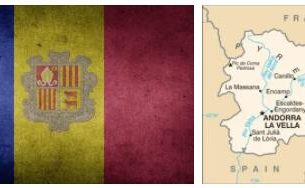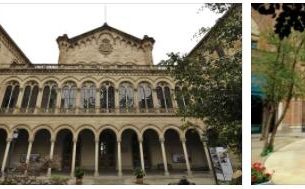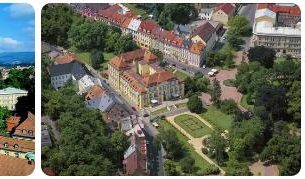Austria – The Alpine Republic
Austria, also known as the “Alpine Republic”, looks back on a long history. The Habsburg monarchs in Vienna ruled not only Austria but large parts of Europe for around seven centuries until the republic was proclaimed in 1918.
Today, Austrian culture is primarily associated with the Viennese coffee houses, the Vienna Secession, the Salzburg Festival and the Klagenfurt literary competition, but also with the romantic little mountain villages and the beautiful skiing and mountaineering areas.
And of course with the unforgettable musical genius Wolfgang Amadeus Mozart, who was born on January 27, 1756 in Salzburg and died on December 5, 1791 in Vienna.
In a special way, the two mountaineers Hermann Buhl and Gerlinde Kaltenbrunner also embody the spirit, the thirst for adventure and the willingness to perform of the people of this country.
Hermann Buhl is still considered one of the best climbers of all time. He was born on September 21, 1924 in Innsbruck and died on June 27, 1957 while descending from the 7,654 m high Chogolisa.
One of his most important mountaineering achievements was the first ascent of the 8,125 m high Nanga Parbat, which he conquered single-handedly.
Gerlinde Kaltenbrunner was born on December 13, 1970 in Kirchdorf/Krems. By 2010 she had conquered 13 of the 14 summits over 8,000 m high worldwide, including Nanga Parbat.
The runoff election of a new Federal President on May 22, 2016 between FPÖ candidate Norbert Hofer (born 1971) and Alexander Van-der Bellen (born 1944) from the Greens resembled a political “thriller”, and that of all other parties against the so-called “right-wing populists” Hofer was supported.
Only after the postal votes had been counted on May 23, Van-der-Bellen was able to prevail with 50.3% against Hofer with 49.7%.
However, the decision of the Constitutional Court had to repeat the election because the envelopes were not properly sealed. In the renewed election on December 4, 2016, Van-der-Bellen received 53.8% and was thus elected Federal President.
Concert pitch A If you dial the telephone number 0043 – 1211101507, you will hear the concert pitch A (440 Hertz)
| Country name | Republic of Austria |
| Form of government | republic |
| National anthem | Land of mountains, land on the river |
| Head of state | President Alexander Van der Bellen |
| Election from 29.9. 2019 |
|
| National holiday | October 26 |
| Population | around 8.9 million (Credit: Countryaah: Austria Population) |
| Ethnicities |
|
| Religions |
|
| Languages | Mainly German, but also Serbian and Turkish. Romanian, Croatian or Polish |
| Capital | Vienna with around 1.9 million residents |
| Surface | 83,858 km² |
| Population | rou |
| Highest mountain | the 3,798 m high Grossglockner in the Hohe Tauern |
| Longest river | Danube with a length in the country of 350 kmkm |
| Largest lake | Neusiedler See with an area of 300 km² |
| International license plate | A. |
| Currency | Euro (1 € = 100 cents) |
| Difference to CET | = Mez or in summer CEST |
| International phone code | + 0043 |
| Mains voltage, frequency | 230 volts, 50 hertz |
| Internet TLD (Top Level Domain) | .at |
Austria: history
Until around the year 1000
Around the year 465 BC BC parts of a celestial body hit near the Chiemsee. A meteorite about 1 km in size that penetrated the atmosphere at a speed of about 45,000 km/h exploded at a height of about 70 km. A myriad of fragments up to about 30 m in size reached the surface of the earth and destroyed the entire Celtic culture in an area of about 2,000 km2 between Lake Chiemsee and today’s Salzburg. The areas around the Chiemsee, which were densely populated by the Celts, were particularly affected.
According to Abbreviationfinder website, only in the 2nd century BC Chr. Migrated from the west Celtic tribes in what is now Austria, and lived there in tribal associations of Noric and Taurisci. From around this time onwards, the Celtic blacksmiths used certain small fragments of the meteorite that they found in the ground as additives in the manufacture of swords. These swords were characterized, among other things, by an extraordinary strength and went down in history as Ferrum Noricum. The Romans in particular carried on a brisk trade to equip their legions with it. In the year 15 BC Chr. The Romans occupied North Tyrol and Vorarlberg and finally divided what is now Austria into three areas: “Raetia” west of the Zillertal, “Noricum” east to the Mürz and Mur and “Pannonia” on the eastern edge of the Alps. To secure the areas, the Romans built the Limes border wall.
From the 3rd century onwards, more and more Germanic tribes invaded Austria. Rome had to withdraw. Up until the year 800 the area was a migration area for the migration of peoples. To 750 the Bavarian dukes Austria brought under their control. During this time the country was also Christianized.
In 788, Charlemagne incorporated the area into his empire. From 900 the Hungarians invaded the area again and again, who could only be defeated in 955 under Otto I (912 – 973), the great. In 976 Otto II (955-983) entrusted the house of the Babenbergers with the administration of the so-called Ostmark, today’s Austria.
From the year 1000 to the 17th century
In 1156, the margraves of the Babenbergs received extensive independence from Emperor Barbarossa. The Ostmark became a hereditary duchy with residence in Vienna. After the fall of the House of Babenberger in the 13th century, the empire fell to the House of Habsburg, which held power in Austria until 1918. In 1438 Duke Albrecht V received the imperial crown for the House of Habsburg for the first time. From then on, the Habsburgs were only carriers of the German Imperial Crown until 1806 with one interruption from 1742 to 1745. In that year the “Holy Roman Empire of the German Nation” ended.
Under Emperor Maximilian I (the last knight) (1459-1519), the Netherlands and the Free County of Burgundy were added to the empire in 1477. Charles V (1500 – 1558), Maximilian’s grandson, was German-Roman Emperor and, as King of Spain, ruler of Spanish possessions in America and Africa. Under Ferdinand I (1503 – 1564), who had been appointed regent for Austria, the Bohemian-Hungarian crown fell to the House of Habsburg in 1526. After the abdication of Charles V in 1556, however, the great empire split into a Spanish and an Austrian line.
In the Thirty Years War the House of Habsburg fought together with Bavaria for Catholic power. It succeeded in the Bohemian-Palatinate War1618 to 1623 to crush the Protestant nobility in Bohemia, which had triggered the war with the Prague window lintel.
The “Turkish Wars” of 1529, 1664 and 1683 were more dangerous for the Austrian Empire. The Turks, who had penetrated as far as Vienna in 1529 and 1683 and besieged the city, could, however, repeatedly be beaten back. In 1699 Austria even fought Hungary from the Turks.
Austria in the 18th and 19th centuries
In the War of the Spanish Succession from 1701 to 1714, the House of Habsburg lost the Spanish crown, but retained the Netherlands and gained parts of Italy. The Austrian monarchy had risen to become a great power.
In the Austrian War of Succession from 1740 to 1748, Prussia and Bavaria tried to divide the empire among themselves, but the ruler Maria Theresa (1717-1780) was able to assert herself against them. In the Silesian Wars (1740 to 1763) Habsburg lost Silesia to Prussia, but received parts of Poland.
In 1805 Napoleon Bonaparte (1769 – 1821) declared war on Austria and won against the Habsburgs and the Russians allied with them at Austerlitz. Austria then lost Veneto to Italy, Tyrol and Vorarlberg to Bavaria. Emperor Franz II (1768-1835) laid down in 1806down the Roman-German imperial dignity, but had already accepted the title of Emperor of Austria as Franz I two years earlier and thus founded the Danube Monarchy.
After the victory over Napoleon, the statesmen of Europe met in Vienna in 1814/15 to discuss the new political situation in Europe. Austria got back Tyrol, Vorarlberg, Veneto, Carinthia, Trieste, Carniola, Galicia, Milan, Salzburg and the Innviertel. At this meeting, Prince Metternich pursued the goal of the Holy Alliance formed by Russia, Prussia and Austria to restore the absolutist order. However, liberal demands could not be prevented in the long run. In 1848 Metternich fell. With the accompanying revolution, Ferdinand I (1793 – 1875) abdicated. The young Franz Joseph I (1830-1916), who ruled Austria until 1916, i.e. for 68 years, came to the throne.
Austria lost power in foreign policy. In 1859 the empire lost Lombardy and in 1866 a battle against Prussia, whereupon the German Confederation was dissolved and the German nation state was founded in 1870/71 under Kaiser Wilhelm I (1797 – 1888) without Austria.
In 1867 Franz Joseph I was crowned King of Hungary. In 1878 Austria tried to occupy Bosnia and Herzegovina and thus came into conflict with Russia. Thereupon Austria and the German Empire founded a federation, which was expanded by Italy in 1882.
20th century until today
In 1908 Austria annexed Bosnia and Herzegovina. The Serbs, supported by the Russians, offered heavy resistance. On June 28, 1914, the Austrian heir to the throne was murdered by Serbian nationalists in Sarajevo, which ultimately triggered the First World War. On July 28, 1914 Austria declared war on Serbia. Germany stood on the side of Austria. In 1918 Austria-Hungary and Germany were defeated by the Allies. This ended the 600-year rule of the Habsburgs. Austria-Hungary fell apart. on 11/11/1918signed the armistice by Emperor Karl I (1887-1922), who was Emperor of Austria from 1916 to 1918 as the successor to Franz Joseph I (1830-1916). According to the Treaty of Saint-Germain-en-Laye, the territories of Austria only comprised 12% of the previous area of the monarchy. A day later the republic was proclaimed.
As in Germany, there was strong political polarization in the new republic. In 1933 Chancellor Dollfuss carried out a coup and created an authoritarian corporate state in which all other parties were banned. In 1936 the Austrian Cabinet signed a friendship agreement with Hitler and granted nationalist Germany great power in the domestic affairs of Austria under Schuschnigg. Hitler forced Schuschnigg in 1938to resign. The German Reichswehr marched into the country to the cheers of the population. Hitler incorporated Austria into the German Reich. During the Second World War, Austrians fought side by side with Germans. Like Germany, Austria was divided into four zones of occupation by the Allies after the end of World War II.
In 1955, in the Vienna State Treaty, the occupying powers and the Austrian government agreed on state unity and the withdrawal of allied troops. Austria became a neutral state. In the same year Austria was admitted to the UN, in 1956 to the Council of Europe and 1960 to the European Free Trade Association. In 1995Austria joined the European Community, today’s EU.
Domestic political conflicts arose from 1986 to 2002 through the right-wing populist party FPÖ and Jörg Haider. He was able to achieve great success with his right-wing national, xenophobic program until 2002. However, since 2003 the party has been weakened significantly.
Heinz Fischer (born 1938) – from the SPÖ – has been the eighth Federal President of the Second Republic since July 8, 2004. In the direct election against his competitor Benita Ferrero-Waldner by the ÖVP, he was elected President with around 52.4% of the votes cast.
A grand coalition under Federal Chancellor Alfred Gusenbauer of the SPÖ and ÖVP has been in power since January 2007. However, the coalition government broke up in early July 2008.
In the new elections to the National Council – the parliament in Austria – in autumn 2008, Werner Faymann stood as candidate for Chancellor instead of Gusenbauer. In the election on September 28, 2008, the SPÖ was the strongest party with 29.71% of the vote, ahead of the ÖVP with 25.61%. Surprising was the performance of the two “right-wing parties” FPÖ – the former party of Jörg Haider – with 18.01% and the BZÖ (Bund Zukunft Österreich) of the new “Haider party” with 10.98%. The two right-wing parties together received around 29% of the vote – a clear shift to the right. After a change in electoral law, the new National Council’s term of office is five years instead of the previous four. And the voting age has been lowered to 16 years.
After tough negotiations, a (grand) coalition of the SPÖ and ÖVP was formed again. On December 2, 2008, the new government under Chancellor Werner Faymann (born 1960 in Vienna) was sworn in (sworn in) by the SPÖ and Vice Chancellor Josef Pröll (born 1968) by the Federal Chancellor.
In the election of the Federal President on April 25, 2010, Heinz Fischer won with 78.9% of the vote and was thus elected Federal President for a further 6 years. The runner-up was Barbara Rosenkranz from the FPÖ, who received 15.6% of the vote.



